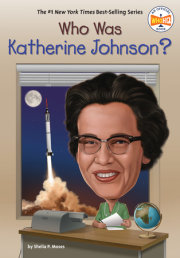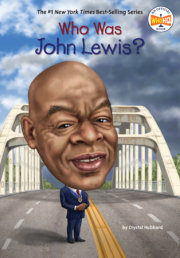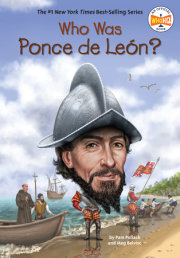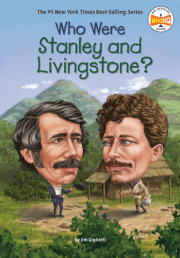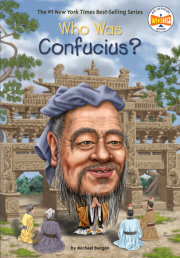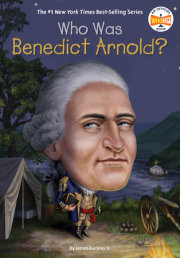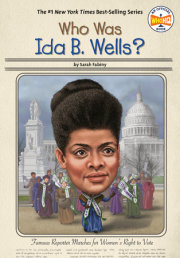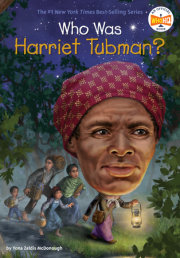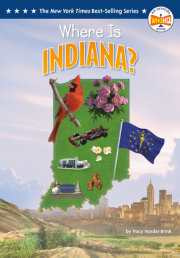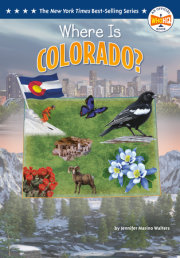Who Were the Navajo Code Talkers? As loud explosions echoed off the rocky island, Samuel Holiday leaped off the landing craft as the huge metal machine slammed into the beach. Samuel was a United States Marine. And the beach was on Iwo Jima, an island in the Pacific Ocean that was held by the Japanese as they battled the United States in World War II. Bullets pinged all around Samuel, while bombs sent huge plumes of black sand into the air. Samuel did his best to walk toward a safe position, but the sand was loose and shifted constantly. Every step was a huge struggle. As he plunged ahead, he saw Marines who had been killed almost as soon as they stepped ashore, lying where they fell.
Samuel clutched his rifle and shouldered the big radio on his back. He had to make it through safely. He had an important job to do. Samuel was one of the Navajo code talkers. These specially trained Marines made sure that thousands of US soldiers, sailors, ships, and planes could get their messages through safely without the Japanese being able to read them. Using their Diné language, the code talkers had become a vital part of the US Marines’ mission. Without a secure way to communicate, that mission on Iwo Jima might end in disaster.
Samuel dug out a place where he was safe from bullets for the moment. He and his partner, Dan Akee, set up their radio gear.
“Bil--dah--has--tanh--ya,” Samuel said over the radio.
“Al--tah--je--jay yoehi ashdla!” On the other end of the call, another Navajo code talker was listening. He told his own partner what Samuel had said: “Pinned down! Attack Sector Five!” The order was passed to Marine artillery. Moments later, bombs landed in front of Samuel, destroying the secret position of the enemy soldiers. The Japanese radio operators who were also listening had no idea what Samuel had said, and their location had been exposed.
Samuel and the other code talkers were in constant danger on Iwo Jima. “The [gun]fire was so intense, men were being killed all around me, and we were pinned down and couldn’t move,” remembered code talker Teddy Draper. “I kept wondering if I was going to live through the day or be killed in my foxhole.” (A foxhole is a dugout pit big enough to hold one or two soldiers.)
Teddy and Samuel did live, and thanks to more than four hundred Navajo code talkers, so did thousands of their fellow Marines. For almost four years, from 1942 to 1945, the code talkers fought in battle after battle. Their unbreakable code helped make sure the enemy could not intercept military communications and that Marines were protected. The code, created using the Navajo language, was never broken. Then, for almost twenty--five years after the war ended, their story was kept as secret as their code—-but now it can be told.
Chapter 1: The Navajo For more than one thousand years, Native Americans of the Navajo Nation have been living in the American Southwest. The Navajo, who call themselves Diné (say: DEE--nay), built homes and villages, created systems of traditions and beliefs, and spoke a unique language.
Europeans arrived on the East Coast of North America in the 1500s and started moving westward toward the lands of the Navajo and many other Native American nations. Soldiers from Spain came to the land of the Navajo in the 1540s. They forced the Navajo off the best farming land and tried to convert the Native Americans to the Spaniards’ Catholic religion. For hundreds of years, the two groups fought throughout the American Southwest, with many deaths on both sides.
In the 1830s, white American settlers began to arrive. A US Army fort was built near Window Rock in 1851, deep in the heart of Navajo territory in what is now Arizona. Soldiers again tried to force the Navajo people off their own land and onto reservations, which were areas set aside for resettling Native Americans. The reservations were often far from the Native Americans’ homes and did not have land that was good for farming or had enough water sources. Few reservations provided much area for shelter. The Navajo tried to resist, but the US Army was too powerful. The army killed horses and sheep, burned cornfields, and killed many Navajo.
Several times, the army forced the Navajo people on a “Long Walk” to a desolate reservation in New Mexico called Bosque Redondo. Hundreds of Navajo died during several of these forced walks, some of which were as long as 450 miles. The Navajo never gave up, however. After resisting the US Army for decades, they signed a treaty in 1868 that gave the Navajo back their homeland. Today, that land is the Navajo Nation. It surrounds the Four Corners region of the United States, where Utah, Colorado, Arizona, and New Mexico meet. Through it all, the Navajo people kept their faith, their traditions, and their language.
In the years that followed, the Navajo language that the US government tried to stamp out would come to play a big part in helping them. All armies use codes during wartime, and the US military is no different. They need codes that cannot be “broken,” or understood, by other armies. A language that was mostly unknown outside the Navajo Nation proved to be perfect.
The US Army had first used Native American languages in World War I, which was fought from 1914 to 1918. Great Britain, France, Russia, and other nations battled Germany and its allies, Austria--Hungary, Bulgaria, and other countries. The United States joined the war in 1917. Incredibly, even though the United States had treated Native Americans miserably for decades, more than twelve thousand Native Americans fought in World War I. At that time, Native Americans were not even citizens of the United States! But they still wanted to do their part in the fight.
The US Army hired Choctaw speakers to use radios and to write messages in their native language. Other Native Americans, including Comanche, Oneida, and Sac and Fox, took part in battles in Europe by sending and receiving messages. Because these languages were specific to each tribal nation, no outsiders knew how to speak or understand them—-including the US Army! The Native American speakers were trusted to pass along messages among other men of their own nations. Germany and its allies didn’t have soldiers who spoke those languages, so the messages remained secret.
In 1939, World War II began in Europe. As they had in World War I, the Navajo and other Native Americans were ready to fight. The Navajo government said, “We resolve that the Navajo Indians stand ready as they did in 1918, to aid and defend our government and Constitution against all . . . armed conflict.”
In early 1942, a man named Philip Johnston read about the use of Native American languages during World War I. Johnston was one of the few non--Navajo people who could speak the Navajo language. He had grown up in the Navajo Nation in Arizona, where his parents were missionaries. Johnston wrote to the US Marines suggesting that the Navajo language could be the basis for an unbreakable code.
On February 28, 1942, Johnston arranged a test to show the Marines how the Navajo language might be used as a code. Four Navajo speakers were matched against four Marine messengers. Using radios, the Navajo speakers accurately sent a test message translated from English into Navajo in twenty seconds. The other messengers took half an hour using the code already in use by the Marines. Major General Clayton Vogel ordered Johnston to find Navajo men to train for this new mission.
Chapter 2: Marine Boot Camp In April 1942, Philip Johnston returned to the Navajo lands where he had once lived. Because of a lack of support from the US government, life there had become very difficult. The American states that controlled the Navajo lands did not provide enough electricity or telephone lines for the Navajo. And they did a poor job running the school systems there. When Johnston called for volunteers, more than two hundred Navajo men showed up. Joining the Marines looked like an opportunity to improve their situation. It was a good job. Being a Marine could also be dangerous work, but the Navajo men believed they came from a long line of warriors, and they were ready to fight.
Samuel “Jesse” Smith remembered that “old men with bows and arrows came to the trading post and wanted to go to war and fight the [Japanese] and save their land. I had the same idea. I wanted to save our land.” Without telling them what their job would be, Johnston chose twenty--nine men who spoke both English and Navajo well.
One of the young Navajo volunteers like Jesse was Chester Nez. He had grown up tending sheep with his family. In 1934, he had been sent away to a junior high school at Fort Defiance, Arizona, which had once actually been Navajo land. At the school, the teachers tried to train the Navajo not to speak their native language or to follow their customs. They forced them to speak only English. At the school, Chester first learned his birthday was in January 1921. Before that, he had kept track of time by the seasons, not by months and years. He later went to high school in Tuba City, Arizona. He continued to learn English but always spoke Navajo at home.
Chester had heard about the Pearl Harbor attack in school. He later wrote, “We . . . had been born to the warrior tradition. Like other Navajos, we saw ourselves as inseparable from the earth we lived upon. And as protectors of what is sacred, we were . . . eager to defend our land.”
When he was twenty--one years old, Chester was accepted as a Marine recruit. His roommate at school, Roy Begay, was also part of the original group. Carl Gorman was thirty--five, and that was too old to join. So he changed his age to thirty so he could get in. Dean Wilson was too young to join. In the Marines’ recruiting office, he saw his file on a desk. He slipped out a paper that showed that his parents had not given their permission and threw it away. “That’s how I got in at age sixteen,” he remembered.
Wilsie Bitsie was just barely tall enough to qualify for the Marines. Eugene Crawford, William McCabe, and Harry Tsosie were among the total of twenty--nine Navajo men who were chosen. They got on a bus for a long ride to San Diego, California, where they would go through training called “boot camp” at Marine Corps Base Camp Pendleton.
After Chester got to the camp, he was given uniforms and weapons. He was shown the bunkhouses where he and the other Navajo Marines would sleep. And he met their trainers, called drill instructors.
At about five o’clock the next morning, the drill instructors woke up Chester and the other Navajo—-loudly! They burst into the bunk room, yelling and shouting instructions. Chester was very surprised. Navajo people rarely raised their voices. They spoke softly to one another. Life for the twenty--nine Navajo at Camp Pendleton would be very different from life in the Navajo Nation.
The Marines kept Chester and the other men to a very tight schedule. Every minute of the day was packed with work, training, or meals. The Navajo were not used to this, and it took a while to adjust. Also, in the Navajo culture, it is not polite to look someone in the eyes. In the Marines, it’s a requirement. “Look me in the eye, Marine,” the drill instructor screamed at Chester. He had to adjust to his new life quickly.
It helped that doing hard work was nothing new. Most of the Navajo had worked all their lives, often outside. They also enjoyed the plentiful food in the Marine camp. Chester’s favorite was a canned meat called Spam, and he also liked Vienna sausages.
The Navajo also proved to be excellent marksmen. Chester had used guns for hunting and protecting his sheep. The all--Navajo Platoon 382 earned one of the camp’s best scores in pistol and rifle shooting at targets.
The Marine trainers were trying to make sure the Navajo, and all the Marines, were tough and ready to deal with any problems that came up in war. One night, pairs of Marines were sent out to stay in the desert. They were given just one canteen of water. Chester, Carl, and the other Navajo drank the water, and then refilled the canteens with liquid from cactus plants. They had learned how to find this water in the desert on Navajo lands. The other Marines came back with empty canteens! Also, the long miles of marching and running were no problem for the Navajo Marines. They often traveled long distances on foot in the wide--open Navajo Nation.
The Navajo were not perfect. For missing assignments or for not completing a job, they were given demerits and light punishment. Wilsie earned more than the others. For forgetting his rifle one time, he had to stand outside with a bucket on his head. For being late too often, he had to bathe Sergeant Duffy, a bulldog that was a mascot for Camp Pendleton.
The men also found time for a little fun. When the Navajo Marines were marching, they often chanted in their native language. The drill instructors thought the Navajo were counting their steps as they marched. Instead, the Navajo Marines were making jokes about the instructors!
After ten weeks, the Navajo men had become Marines. One of their training commanders wrote to the group, “Yours has been one of the outstanding platoons in the history of this Recruit Depot. . . . You obey orders like seasoned and disciplined soldiers. You have maintained rugged health. . . . The Marine Corps is proud to have you in its ranks.”
A few days later, on June 29, all the Navajo Marines were sent to nearby Camp Elliott. They were taken to a room and told they were going to get a special mission. Eugene Crawford remembered thinking that if this boring room was their new home, that the mission probably wasn’t anything special.
But then the group was told that their new assignment in the Marines would be something very secret, and something very special indeed.
Copyright © 2021 by James Buckley Jr.. All rights reserved. No part of this excerpt may be reproduced or reprinted without permission in writing from the publisher.














